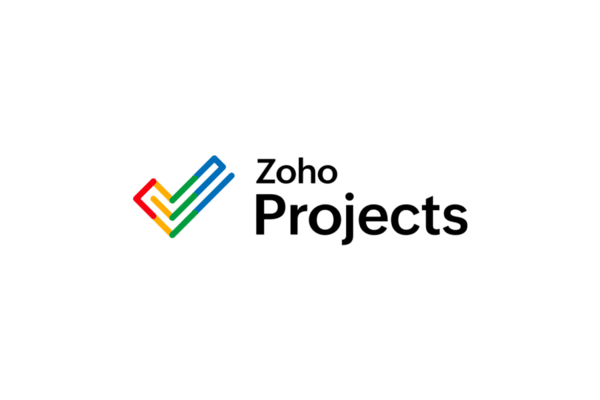Key takeaways
The rest of this article will directly compare Trello vs. Jira on these criteria and other factors in greater detail.
At a Glance
When comparing Trello vs. Jira, it is important to recognize that both offer useful core project management features that can scale as your needs change but that each tool comes with different strengths. Trello is easy to implement and houses impressive tools for visualizing projects, while Jira offers rich reporting and analytical capabilities and automations.
Trello: Best for Small Teams

Trello, from Atlassian, is a consistently one of our top project management software solutions for individuals and teams of all sizes. Many users select Trello over other project management tools because of the balance of value and ease of use this tool brings forth. Trello’s free plan is very generous, extending unlimited project/task cards, 10 boards per workspace, unlimited board Power-Ups, and unlimited storage to all users.
But Trello’s greatest strength is its simplicity. Following the traditional format of a kanban-style project view, users can easily drag and drop project tasks, update and visualize project statuses and categories, and add accessible notes, comments, and subtasks to each project card for improved team-wide collaboration and task tracking.
Key Features
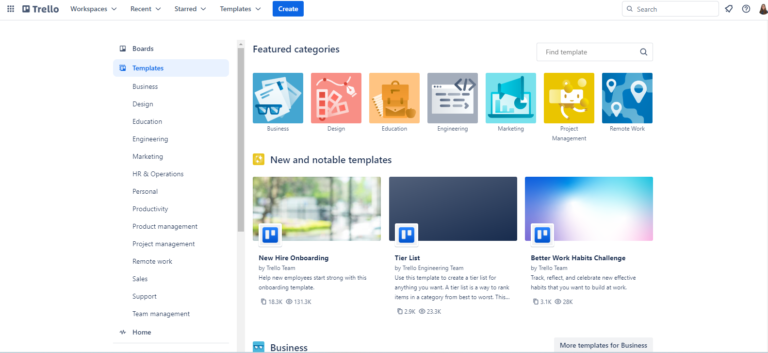
- Kanban-like project boards: All Trello plans come with kanban-style project boards and visual cards that can be dragged and dropped as statuses or working groups change. Users can work with unlimited cards across multiple boards, and unlimited boards are available on all paid plans.
- Task and subtask management: Users can easily visualize and manage tasks, as well as increasingly granular subtasks, with cards, comments on cards, checklists, and more.
- Project templates: Trello community templates are available in all plans and cover a wide variety of business and personal project categories. Premium and Enterprise plan users can also use workspace-level templates to better organize their overall project infrastructure.
- Power-Ups: Third-party plugins, called Power-Ups, are available for more than 200 vendor apps and tools. All user plans have access to unlimited Power-Ups.
- Scalable storage: All Trello plans provide unlimited Workspace storage to users. The Free plan has a limit of 10 MB per file, and the Standard plan has a limit of 250 MB per file; the top-tier plans have no file-storage limits.
Pros
Cons
Learn more in our Trello review.
Jira: Best for Large Teams

Jira is another leading project and workflow management solution from Atlassian that makes collaboration among cross-functional teams run more seamlessly. With its deep integration and compatibility with both ATlassian’s extensive software ecosystem, Jira is the ideal PM tool for businesses, software developers, and technical teams that need to manage complex workflows and track issues across different verticals.
Many aspects of its interface are comparable to Trello, but it’s a more complex solution with more features. Some of its standout features include analytics and dashboards in all plans, powerful automations and “actions,” approvals and forms for additional workload management capabilities, and issue-tracking features.
Key Features
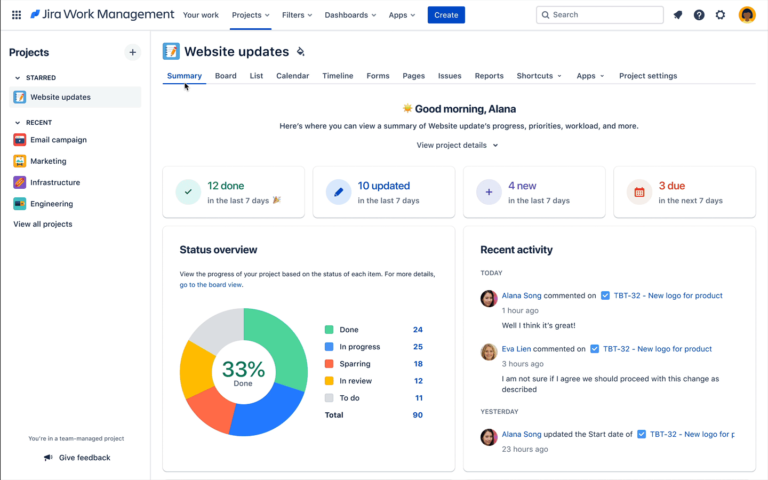
- Multiple project views: Regardless of which Jira plan you select, you’ll have access to list, timeline, calendar, board, and summary project views.
- Monthly automation runs: Each plan comes with a set allowance of automation runs per month, which can be set up for single projects, multiple projects, or project-wide automation use cases. The Premium plan comes with 1,000 rule runs per paid user per month. If your team uses the full 35,000 user allowance in a plan, this means you could have up to 35 million automations running per month.
- Reporting and dashboards: All users have access to reporting and dashboarding features, with the ability to create custom tracking or use prebuilt reports and dashboards. Dashboards can work for individual or project-wide metrics.
- Built-in security and compliance: All Jira plans come with password policies, encryption in transit and at rest, business continuity and disaster recovery support, and mobile device management. Specific paid plans include additional features like audit logs, anonymous access, data residency, and IP whitelisting.
- Global configuration: Once a project team or organization has established a workflow, settings, automation rules, or other approach that works well for their goals and aligns with their methodology, this process can be standardized through Jira’s global configuration settings, which makes it easier to transfer and enforce this process to future projects.
Pros
Cons
Learn more in our Jira review.
Best for Pricing: Depends on Team Size
Trello and Jira both offer reasonably priced subscription plans. Smaller teams and individuals will likely prefer Trello’s approach to pricing, while larger teams typically prefer Jira’s scalable and tiered approach to pricing.
Trello’s Free plan is $0 for unlimited users, though a limit of 10 users will be enforced starting on April 8, 2024. Any Free plan users who have added 10 or more collaborators before this date will be able to keep this number, but they won’t be able to add any additional users moving forward unless they remove existing users or upgrade to a paid plan.
For paid solutions, Trello’s Standard plan is $5 per user per month, billed annually, or $6 per user billed monthly. The Premium plan is $10 per user per month, billed annually, or $12.50 per user billed monthly. The Enterprise plan is between $7.38 and $17.50 per user per month, billed annually, depending on the user count you have between 50 and 5,000 users. Customers who require space for more than 5,000 users will need to contact the Atlassian Trello team directly for pricing.
In contrast, Jira’s Free plan is $0 for up to 10 users. The Standard plan is between $3.01 and $5 per user per month, billed monthly, or between $500 and $1,053,500 billed annually, depending on user tier. The Premium plan is between $6.02 and $10 per user per month, billed annually, or between $1,000 and $2,107,000 billed annually, depending on user tier.
Jira’s approach to monthly subscriptions is very similar to how Trello approaches its pricing plans, but Jira goes in a different direction for annual subscriptions with user tiers. Pricing is divided into tiered groups to better represent the pricing needs of teams ranging from one to 35,000 users.
For example, the first tier represents teams with one to 10 users. Whether you have one user or 10 users or some number in between, annual pricing for the Standard plan will remain at $500 for that year. If you’re on the lower end of the tier, the price will be higher per user and less reasonable when compared to Trello, but if you’re on the higher end of any tier, Jira tends to be more affordable and scalable.
The number of users in each Jira tier varies greatly for the Standard and Premium plans, but especially for larger teams, the tier groups expand to allow for more flexibility. As an example, if you are an enterprise with 900 users who need access to a Jira Premium account, the annual price for that subscription will be $67,000 per year. This price will remain the same as long as your user count stays within that tier range, which is 801 to 1,000 users. Again, this allows for greater flexibility and better pricing value for enterprise-size teams. Pricing tiers go up to 35,000 users for Jira .
In summary, Trello is affordable and offers straightforward pricing for smaller teams and teams that don’t need constant up-and-down scalability. Jira tends to be more affordable for larger teams that want to pay through the annual tier subscription plans.
Best for Core Features: It Depends
Deciding between Trello and Jira based on core features is a difficult decision, as the best choice depends on your team size, project types, and other priorities. Both products are sold by Atlassian, but they’re designed to address different project management use cases and team pain points.
Trello is better for one-off, smaller-scale projects and smaller teams or individuals who require agility. Its best core features include a clean kanban interface, a deep and diverse library of project templates, extensive collaboration and task management capabilities, and drag-and-drop usability with no-code automations. The tool may fall short for users who require extensive reporting and dashboarding capabilities or complex, multi-step, or cross-project automation workflows.
Jira’s core features cater to a more technical, enterprise-level audience. Its standout core features include access for up to 35,000 users, multiple project views in all plans, forms and other workflow-based tools, reporting and dashboarding capabilities, and various admin, security, and compliance management features. This software may not be the best option for users who want a tool with a smaller learning curve and a simple user interface, as well as for users who want a wide range of templates and support resources to help them get started.
Best for Ease of Implementation: Trello
Trello and Jira have fairly straightforward software subscription models and setup processes, but Trello wins because of its intuitive interface. In contrast, Jira has more bells and whistles that can make it overwhelming to new PM users and non-developers; generally speaking, users are more likely to misconfigure Jira than Trello.

User reviews of Trello consistently comment on how easy the tool is to use. Its kanban interface will feel familiar and navigable to users of all backgrounds, especially because its drag-and-drop usability and prebuilt, well-integrated automations limit the technical expertise necessary to get projects up and running. Additionally, the platform comes with dozens of prebuilt templates created by both the Atlassian and Trello teams and other users. If there’s a business case for a certain project or board setup, there’s a good chance that a Trello template already exists and is ready to be customized.
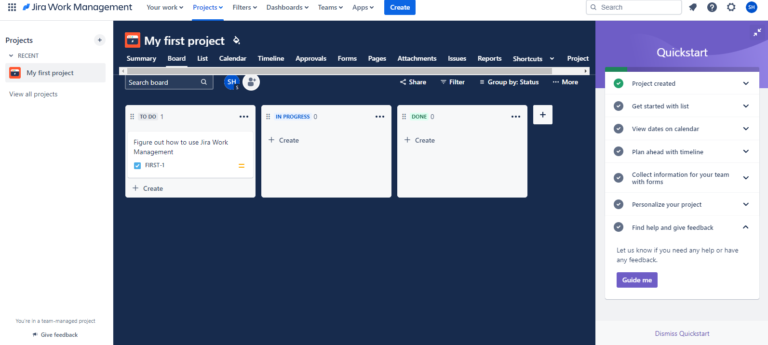
Jira is a more difficult tool to operate, as it is designed with features that support more complex workflows and technical project initiatives, including approvals and forms workflows and several features for issue management and tracking. Additionally, while it’s nice to have dashboards and reports available without paid plan subscriptions or add-ons, the reporting infrastructure has limited templates and supportive features to help users start from scratch.
While the foundational kanban board view for Trello is straightforward and each of its features is easy to toggle between, many users have difficulty understanding where and how they should get started with using Jira. Trello also offers a greater variety and higher quality project templates overall, which is a major asset for teams that want or need more guidance for launching a new project board or initiative. Therefore, Trello wins for ease of implementation and overall usability.
Best for Reporting and Analytics: Jira
By and large, Jira is a better reporting and analytics solution than Trello, especially for users of free and lower-tier plans.
Jira’s Reports feature is available as a tab on every project board in a user’s account. From the Reports tab, users can generate simple, complex, high-level, and granular reports in the following formats and focus areas: average age, created vs. resolved issues, pie chart, recently created issues, resolution time, single level group, time since issues, time tracking, user workload, and workload pie chart.
For dashboarding in Jira, users can create cross-project and project-wide dashboards and can choose from 28 different dashboard gadgets. Many of these gadgets focus on similar data as the reports listed above, but dashboards also cover areas like personal assignments, heat maps, bubble charts, and watched issues across multiple projects.
Jira’s user-friendly, robust reports and dashboards are available across all plans. In contrast, Trello only offers its relatively simplistic dashboard view to Premium and Enterprise plan users. Another important detail, Trello only supports simple data exports for these plans, meaning it’s also difficult to export and use this data in a third-party analytics or dashboarding tool without extensive manual effort.
In summary, Jira is the clear winner for reporting and analytical capabilities.
Best for Automations: Jira
At surface level, Trello appears to be the better choice for automations because of how many command runs are available in each of its plans; however, Jira offers similarly competitive automation quantities per month with the added advantage of more complex automation rules and options. Therefore, Jira wins in this category.
Trello offers the following automation quantities per plan:
- Free: 250 Workspace command runs per month
- Standard: 1,000 Workspace command runs per month
- Premium: Unlimited command runs
- Enterprise: Unlimited command runs
In contrast, Jira plans offer monthly automations in these quantities:
- Free: 100 rule runs per month
- Standard: 1,000 rule runs per month
- Premium: 1,000 rule runs per paid user per month
While this data indicates that Trello’s automation commands are more expansive, most user reviews reveal that Jira’s automations are more useful and capable of handling more intricate and complex automation use cases. According to each product’s pricing pages, Jira is capable of setting automation rules “within a single project, across multiple projects, or across all projects on your site,” whereas Trello automations are “built into every Trello board” and focused at the individual board level.
If you’re looking for high quantities of simple automations, Trello may be a better fit, but for more complex, wide-ranging, and cross-project automation workflows, Jira is the best solution.
Who Shouldn’t Use Trello or Jira?
While Trello and Jira both check off a lot of users’ requirements for the project management software they select, each tool has its limitations that may make it less effective for certain audiences and use cases. These are some of the reasons why you may not want to select either Trello or Jira:
Who Shouldn’t Use Trello
- Users who need robust analytics and reporting tools
- Users who prefer multiple project views that go beyond kanban
- Users who need to set up advanced or multi-step automations and workflows
- Users who require round-the-clock or hands-on customer support
- Enterprises that need to add thousands of users to their PM software
Who Shouldn’t Use Jira
- Users who want free software for unlimited users
- Users who require round-the-clock or hands-on customer support
- Users who require highly visual and intuitive task management features
- Users who need to set up granular customizations in project fields, dashboards, etc.
- Users who are looking for easy-to-use, less technical project management software
5 Best Alternatives to Trello and Jira
If neither Trello nor Jira offers the features and functionality that you need for project management, consider one of these alternatives:
monday work management
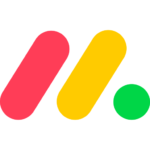
monday work management is a flexible project management software solution that many users select for its customizability. Regardless of which plan you select, you’ll have the ability to granularly customize project fields, groupings, and automation workflows to your exact requirements. All users also receive access to a robust dashboard and reporting solution, which they can simply toggle to and from their main project boards.
Learn more: Trello vs. monday.com and monday.com vs. Jira
ClickUp

ClickUp is one of the most popular project management software solutions available today, providing users with a highly customizable tool regardless of their subscription tier. ClickUp’s free tier is a comprehensive option for many teams, offering unlimited tasks, 100 MB of storage, several project views, and 24/7 customer support access to an unlimited number of users. ClickUp’s paid plans are also relatively affordable compared to most equivalent competitors.
Zoho Projects
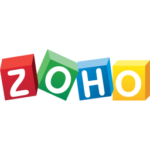
Zoho Projects is a favorite project management tool for businesses of varying backgrounds, including more technical teams that require advanced features for product and software development projects. Some of Zoho Projects’ unique features include blueprints, issue tracking and SLA, task dependencies, and critical path. Zoho Projects can be used as a standalone tool, or it can be accessed as part of Zoho One if users want a unified solution for marketing and sales, support, HR, accounting, operations, and project management software.
Asana

Asana is a leading project management solution that works best for businesses that want an easy-to-use tool that emphasizes collaboration features and task management. With this tool, users can assign and delegate tasks to their team members and set task due dates, making it easier to track and stay on schedule for important project milestones. Many of its free plan features are comparable to Trello, though Asana offers a few additional project views to free plan users.
Review Methodology
To pull together this comparison of Trello and Jira, I first focused on research efforts on the project management software criteria that tend to be most important to the widest variety of users. I reviewed each tool through the lenses of affordability, ease of use and accessibility, flexibility, scalability, and enterprise readiness. The review process involved both hands-on testing of each of these tools’ core features as well as close reviews of product pages, key feature listings, online user reviews, and Atlassian’s own comparisons of these two tools in their portfolio of solutions.
Bottom Line: Trello vs Jira
Trello and Jira each have dedicated followings and loyal customers—and for good reason. Both of these project management tools offer robust features to users that cover a wide range of project, task, and workflow management needs. What’s more, both of these tools offer free and lower-cost plans for smaller teams and scalable enterprise-level versions for teams with dozens or even hundreds of users.
Because both tools are available in free-plan versions, the best way to determine which tool is the better fit for your team is to make a free account and give up to 10 users the chance to experiment with each option. Hands-on testing from different team members’ perspectives will prove your most valuable research and decision-making asset, giving you a comprehensive internal dataset to reference when making your final decision between Trello and Jira.
Read next: 10 Best Project Management Software Reviewed


